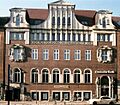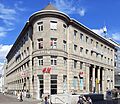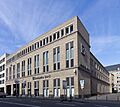Deutsche Bank facts for kids
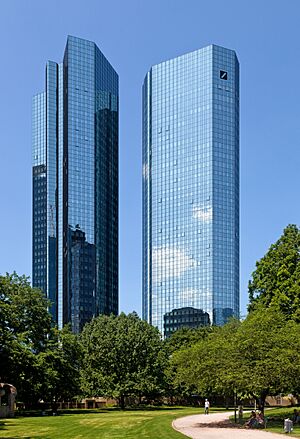
Deutsche Bank Twin Towers in Frankfurt, Germany
|
|
| Public (Aktiengesellschaft) | |
| Traded as | |
| ISIN | ISIN: [https://isin.toolforge.org/?language=en&isin=DE0005140008 DE0005140008] |
| Industry | |
| Founded | 10 March 1870 |
| Founders |
|
| Headquarters | Deutsche Bank Twin Towers,
,
Germany
|
|
Key people
|
|
| Services |
|
| Revenue | |
|
Operating income
|
|
| AUM | |
| Total assets | |
| Total equity | |
|
Number of employees
|
90,130 (2023) |
Deutsche Bank AG (German pronunciation: [ˈdɔʏtʃə ˈbaŋk ʔaːˈɡeː]), sometimes referred to simply as Deutsche, or internally as DB, is a German multinational investment bank and financial services company headquartered in Frankfurt, Germany, and dual-listed on the Frankfurt Stock Exchange and the New York Stock Exchange.
Deutsche Bank was founded in 1870 in Berlin. From 1929 to 1937, following its merger with Disconto-Gesellschaft, it was known as Deutsche Bank und Disconto-Gesellschaft or DeDi-Bank. Other transformative acquisitions have included those of Mendelssohn & Co. in 1938, Morgan Grenfell in 1990, Bankers Trust in 1998, and Deutsche Postbank in 2010.
As of 2018, the bank's network spanned 58 countries with a large presence in Europe, the Americas, and Asia. It is a component of the DAX stock market index and is often referred to as the largest German banking institution, with Deutsche Bank holding the majority stake in DWS Group for combined assets of 2.2 trillion euros, rivaling even Sparkassen-Finanzgruppe in terms of combined assets.
Deutsche Bank has been designated a global systemically important bank by the Financial Stability Board since 2011. It has been designated as a Significant Institution since the entry into force of European Banking Supervision in late 2014, and as a consequence is directly supervised by the European Central Bank.
According to a 2020 article in the New Yorker, Deutsche Bank had long had an "abject" reputation among major banks, as it has been involved in major scandals across various issue areas.
History
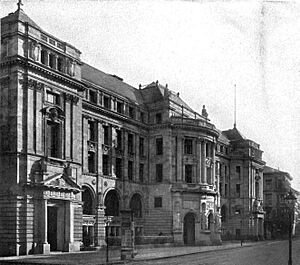
1870–1933
Deutsche Bank was founded in 1870 in Berlin as a specialist bank for financing foreign trade and promoting German exports. It subsequently played a large part in developing Germany's financial services industry, as its business model focused on providing finance to industrial customers. The bank's statute was adopted on 22 January 1870, and on 10 March 1870 the Prussian government granted it a banking license. The statute laid great stress on foreign business:
The object of the company is to transact banking business of all kinds, in particular, to promote and facilitate trade relations between Germany, other European countries and overseas markets.
Prior to the founding of Deutsche Bank, German importers and exporters were dependent upon British and French banking institutions in the world markets—a serious handicap in that German bills were almost unknown in international commerce, generally disliked and subject to a higher rate of a discount than English or French bills.
The founding members were: Hermann Zwicker (Bankhaus Gebr. Schickler, Berlin); Anton Adelssen (Bankhaus Adelssen & Co., Berlin); Adelbert Delbrück (Bankhaus Delbrück, Leo & Co.); Heinrich von Hardt (Hardt & Co., Berlin, New York); Ludwig Bamberger (politician, former chairman of Bischoffsheim, Goldschmidt & Co); Victor Freiherr von Magnus (Bankhaus F. Mart Magnus); Adolph vom Rath (Bankhaus Deichmann & Co., Cologne); Gustav Kutter (Bankhaus Gebrüder Sulzbach, Frankfurt); and Gustav Müller (Württembergische Vereinsbank, Stuttgart). The First directors were Wilhelm Platenius, Georg Siemens, and Hermann Wallich. Georg Siemens was a son of a cousin of Werner von Siemens. The bank initially operated from the first floor of a building at 21 Französische Strasse, then in 1871 moved to premises near the Berlin Stock Exchange, and in 1876 started building its massive head office complex on Mauerstrasse.
The bank's first domestic branches, inaugurated in 1871 and 1872, were opened in Bremen and Hamburg. Its first overseas offices opened in Shanghai and Yokohama in 1872, and London in 1873, followed by South American offices between 1874 and 1886. The branch opening in London, after one failure and another partially successful attempt, was a prime necessity for the establishment of credit for the German trade in what was then the world's money center. Deutsche Bank also took advantage of the Panic of 1873 by taking over a number of banks in liquidation, including the Berlin-based Deutsche Union which had itself consolidated a number of failed banks in the early 1870s.
Major projects in the early years of the bank included the Northern Pacific Railroad in the US and the Baghdad Railway (1888). In Germany, the bank was instrumental in the financing of bond offerings of steel company Krupp (1879) and introduced the chemical company Bayer to the Berlin stock market.
The second half of the 1890s saw the beginning of a new period of expansion at Deutsche Bank. The bank formed alliances with large regional banks, giving itself an entry into Germany's main industrial regions. It thus formed community-of-interests partnerships with Bergisch-Märkische Bank in Elberfeld and Schlesischer Bankverein in Breslau, linked to the fast-growing industrial economies of the Rhineland and Silesia respectively; it eventually acquired the two banks in 1914 and 1917 respectively. Joint ventures were symptomatic of the concentration then under way in the German banking industry. For Deutsche Bank, domestic branches of its own were still something of a rarity at the time; the Frankfurt branch dated from 1886 and the Munich branch from 1892, while further branches were established in Dresden and Leipzig in 1901.
In 1889, Deutsche Bank participated in the creation of the Deutsch-Asiatische Bank in Shanghai, in 1894, of the Banca Commerciale Italiana in Milan, and in 1898, of the Banque Internationale de Bruxelles.
In addition, the bank rapidly perceived the value of specialist institutions for the promotion of foreign business. Gentle pressure from the Foreign Ministry played a part in the establishment of Deutsche Ueberseeische Bank in 1886 and the stake taken in the newly established Deutsch-Asiatische Bank three years later, but the success of those companies showed that their existence made sound commercial sense. By end-1908, Deutsche was by far the largest German joint-stock bank by total deposits, with a total of 489 million Marks ahead of Dresdner Bank (225 million), Disconto-Gesellschaft (219 million), Darmstädter Bank (109 million) and A. Schaaffhausen'scher Bankverein (72 million). At that time, Deutsche Bank was referred to as one of the four "D-Banks" (all of which had names starting with a D) that dominated German commercial banking, together with Darmstädter Bank, Disconto-Gesellschaft, and Dresdner Bank.
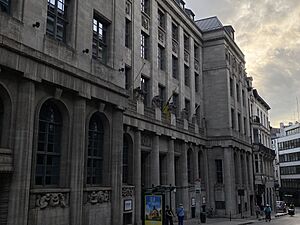
During World War I and in its immediate aftermath, the operations of Deutsche Bank in Brussels, London, Tokyo and Yokohama were expropriated; conversely, its activity in the Ottoman Empire expanded considerably, and it greatly expanded its footprint in Germany. In 1919, the bank purchased the state's share of Universum Film Aktiengesellschaft (UFA). In 1926, the bank assisted in the merger of Daimler and Benz.
The bank merged with Disconto-Gesellschaft in 1929 and rebranded itself Deutsche Bank und Disconto-Gesellschaft, sometimes referred to as DeDi-Bank. By 1930, Deutsche Bank & Disconto-Gesellschaft maintained a similar dominant position as before World War I, with 4.8 billion Reichsmarks in total deposits ahead of Danat-Bank (2.4 billion), Dresdner Bank (2.3 billion), Commerz- und Privatbank (1.5 billion), Reichs-Kredit-Gesellschaft (619 million), and Berliner Handels-Gesellschaft (412 million).
In the crisis summer of 1931 the Deutsche Golddiskontbank, a subsidiary of the Reichsbank, acquired 35 percent of DeDi-Bank's equity as part of a sector-wide rescue, bringing total government ownership of the bank to 38.5 percent. This did not, however, result in significant government interference in the management of the company, unlike at Dresdner Bank whose capital was near-completely nationalized.
1933–1945
After Adolf Hitler became leader of Germany, Deutsche Bank increasingly became integrated into the Nazi power structures, and fully implemented the Nazi policy of aryanization. In 1934 it dismissed its three Jewish management board members, Oscar Wassermann, Theodor Frank, and Georg Solmssen; in 1938 it dismissed its last Jewish supervisory board member. By the end of 1938, it had been involved as an intermediary and lender in at least 363 cases of expropriation of Jewish-owned businesses. In 1938, it acquired Jewish-controlled German bank Mendelssohn & Co. under duress. Meanwhile, the Nazi government fully re-privatized Deutsche Bank in 1935-1937, largely out of budgetary considerations. Its name changed back to Deutsche Bank in 1937.
While the Nazi policies of financial repression were largely unhelpful to the domestic business of Deutsche and other German commercial banks, its expansionary behavior created opportunities that Deutsche Bank pursued. In 1938 following Hitler's Anschluss of Austria, Deutsche Bank gradually took control of Creditanstalt-Bankverein, the former country's leading bank. On 26 March 1938 the latter was coerced to enter a "friendship agreement" with Deutsche Bank, by which the latter secured a presence in its board of directors. Creditanstalt executive Louis de Rothschild was immediately arrested and imprisoned, deprived of his position and property, then released upon payment of $21,000,000, believed to have been the largest bail bond in history for any individual, and migrated to the U.S. in 1939 after more than one year in custody. Later in 1938, Creditanstalt was jointly taken over, without compensation, by German government holding VIAG, Deutsche Bank, and the Reichsbank, which held respectively 51 percent, 25 percent, and 12 percent of its capital. In April 1942, Deutsche Bank raised its ownership to 51 percent by acquiring a block of shares from VIAG. During wartime, the Creditanstalt expanded its operations into Nazi-occupied Czechoslovakia, Poland, Yugoslavia, and in Nazi-allied Bulgaria.
In September 1938, following the Munich Agreement, Deutsche Bank took over the branches of Prague-based Böhmische Union Bank (BUB) in the Sudetenland. In March 1939, it forcibly took over control of the BUB itself, in which it built a majority stake complemented with prior shareholding of Creditanstalt. It also took over management control of the National Bank of Greece during the Axis occupation of Greece, without however acquiring ownership out of consideration for Italian sensitivities. Through the Creditanstalt-Bankverein, Deutsche Bank also became a major shareholder of the Allgemeiner Jugoslawischer Bankverein (AJB), which had been formed in 1928 from the two former branches of the Wiener Bankverein in Belgrade and Zagreb, and of the Landesbank für Bosnien und Herzegowina in Sarajevo, together with the Société Générale de Belgique and its affiliate Banque Belge pour l'Étranger. In 1940, following the German invasion of Belgium, Deutsche Bank bought out the Belgian stake under duress and became the AJB's dominant shareholder, with 88 percent held either directly or through Creditanstalt. Deutsche Bank simultaneously took control of the Landesbank in Sarajevo. Following the German invasion of Yugoslavia, the AJB was divided into two separate institutions, respectively the Bankverein AG Belgrad in occupied Serbia, and the Bankverein für Kroatien AG in the Independent State of Croatia. Both these banks' assets were eventually confiscated by the newly established Communist authorities in October 1944, and they were subsequently liquidated.
During the war, Deutsche Bank provided banking facilities for the Gestapo and, through its branch in Katowice, loaned the funds used to build the Auschwitz camp and the nearby IG Farben facilities. Deutsche Bank publicly acknowledged its involvement at Auschwitz in 1999. It also was a principal participant in the Nazi regime's gold transactions. Between 1942 and 1944, Deutsche Bank purchased 4,446 kg of gold from the Reichsbank, of which 744 kg came from Holocaust victims.
In an effort to come to terms with its past during the Nazi era, Deutsche Bank in 1995 published a history volume that detailed its entanglement with the dictatorship. In December 1999, along with other major German companies, Deutsche Bank contributed to a US$5.2 billion compensation fund following lawsuits brought by Holocaust survivors; U.S. officials had reportedly threatened to block Deutsche Bank's $10 billion purchase of Bankers Trust if it did not contribute to the fund.
1945–2000
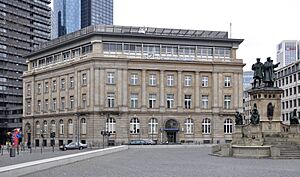
Following Germany's defeat in World War II, the Allied authorities, in 1948, ordered Deutsche Bank's break-up into regional banks. These regional banks were later consolidated into three major banks in 1952: Norddeutsche Bank AG; Süddeutsche Bank AG; and Rheinisch-Westfälische Bank AG. In 1957, these three banks merged to form Deutsche Bank AG with its headquarters in Frankfurt.
In 1959, the bank entered retail banking by introducing small personal loans. In the 1970s, the bank pushed ahead with international expansion, opening new offices in new locations, such as Milan (1977), Moscow, London, Paris, and Tokyo. In the 1980s, this continued when the bank paid U$603 million in 1986 to acquire Banca d'America e d'Italia.
In 1972, the bank established its Fiduciary Services Division which provides support to its private wealth division.
At 8:30 am on 30 November 1989, Alfred Herrhausen, chairman of Deutsche Bank, was killed when a car that he was in exploded while he was traveling in the Frankfurt suburb of Bad Homburg. The Red Army Faction claimed responsibility for the blast.
In 1989, the first steps towards creating a significant investment-banking presence were taken with the acquisition of Morgan, Grenfell & Co., a UK-based investment bank which was renamed Deutsche Morgan Grenfell in 1994. In 1995 to greatly expand into international investments and money management, Deutsche Bank hired Edson Mitchell, a risk specialist from Merrill Lynch, who hired two other former Merrill Lynch risk specialists Anshu Jain and William S. Broeksmit. By the mid-1990s, the buildup of a capital-markets operation had got underway with the arrival of a number of high-profile figures from major competitors. Ten years after the acquisition of Morgan Grenfell, the US firm Bankers Trust was added. Bankers Trust suffered losses during the 1998 Russian financial crisis since it had a large position in Russian government bonds, but avoided financial collapse by being acquired by Deutsche Bank for $10 billion in November 1998. On 4 June 1999, Deutsche Bank merged its Deutsche Morgan Grenfell and Bankers Trust to became Deutsche Asset Management (DAM) with Robert Smith as the CEO. This made Deutsche Bank the fourth-largest money management firm in the world after UBS, Fidelity Investments, and the Japanese post office's life insurance fund. At the time, Deutsche Bank owned a 12% stake in DaimlerChrysler but United States banking laws prohibit banks from owning industrial companies, so Deutsche Bank received an exception to this prohibition through 1978 legislation from Congress.
Deutsche continued to build up its presence in Italy with the acquisition in 1993 of Banca Popolare di Lecco from Banca Popolare di Novara for about $476 million. In 1999, it acquired a minority interest in Cassa di Risparmio di Asti.
21st century
In the 11 September 2001 terrorist attacks the Deutsche Bank Building in Lower Manhattan, formerly Bankers Trust Plaza, was heavily damaged by the collapse of the South Tower of the World Trade Center. Demolition work on the 39-story building continued for nearly a decade, and was completed in early 2011.
In October 2001, Deutsche Bank was listed on the New York Stock Exchange. This was the first NYSE listing after interruption due to 11 September attacks. The following year, Josef Ackermann became CEO of Deutsche Bank and served as CEO until 2012 when he became involved with the Bank of Cyprus. Then, beginning in 2002, Deutsche Bank strengthened its U.S. presence when it purchased Scudder Investments. Meanwhile, in Europe, Deutsche Bank increased its private-banking business by acquiring Rued Blass & Cie (2002) and the Russian investment bank United Financial Group (2005) founded by the United States banker Charles Ryan and the Russian official Boris Fyodorov which followed Anshu Jain's aggressive expansion to gain strong relationships with state partners in Russia. Jain persuaded Ryan to remain with Deutsche Bank at its new Russian offices and later, in April 2007, sent the president and chairman of the management board of VTB Bank Andrey Kostin's son Andrey to Deutsche Bank's Moscow office. Later, in 2008, to establish VTB Capital, numerous bankers from Deutsche Bank's Moscow office were hired by VTB Capital. In Germany, further acquisitions of Norisbank, Berliner Bank and Deutsche Postbank strengthened Deutsche Bank's retail offering in its home market. This series of acquisitions was closely aligned with the bank's strategy of bolt-on acquisitions in preference to so-called "transformational" mergers. These formed part of an overall growth strategy that also targeted a sustainable 25% return on equity, something the bank achieved in 2005.
On 1 October 2003, Deutsche Bank and Dresdner Bank entered into a payment transaction agreement with Postbank to have Postbank process payments as the clearing center for the three banks.
Since the mid-1990s Deutsche Bank commercial real estate division offered Donald Trump financial backing, even though in the early 1990s Citibank, Manufacturers Hanover, Chemical, Bankers Trust, and 68 other entities refused to financially support him.
In 2008, Trump sued Deutsche Bank for $3 billion and a few years later, he shifted his financial portfolio from the investment banking division to Deutsche Bank private wealth division with Rosemary Vrablic, formerly of Citigroup, Bank of America, and Merrill Lynch, becoming Trump's new personal banker at Deutsche Bank.
In 2007, the company's headquarters, the Deutsche Bank Twin Towers building, was extensively renovated for three years, certified LEED Platinum and DGNB Gold.
In 2010, the bank developed and owned the Cosmopolitan of Las Vegas, after the casino's original developer defaulted on its borrowings. Deutsche Bank ran it at a loss until its sale in May 2014. The bank's exposure at the time of sale was more than $4 billion, and sold the property to Blackstone Group for $1.73 billion.
Housing credit bubble and CDO market
On 3 January 2014, it was reported that Deutsche Bank would settle a lawsuit brought by US shareholders, who had accused the bank of bundling and selling bad real estate loans before the 2008 downturn. This settlement came subsequent and in addition to Deutsche's $1.93 billion settlement with the US Housing Finance Agency over similar litigation related to the sale of mortgage-backed securities to Fannie Mae and Freddie Mac.
Leveraged super-senior trades
Former employees including Eric Ben-Artzi and Matthew Simpson have claimed that, during the crisis, Deutsche failed to recognize up to $12 billion of paper losses on its $130 billion portfolio of leveraged super senior trades, although the bank rejects the claims. A company document of May 2009 described the trades as "the largest risk in the trading book", and the whistleblowers allege that had the bank accounted properly for its positions its capital would have fallen to the extent that it might have needed a government bailout. One of them claims that "If Lehman Brothers didn't have to mark its books for six months it might still be in business, and if Deutsche had marked its books it might have been in the same position as Lehman."
Deutsche had become the biggest operator in this market, which were a form of credit derivative designed to behave like the most senior tranche of a CDO. Deutsche bought insurance against default by blue-chip companies from investors, mostly Canadian pension funds, who received a stream of insurance premiums as income in return for posting a small amount of collateral. The bank then sold protection to US investors via the CDX credit index, the spread between the two was tiny but was worth $270m over the 7 years of the trade. It was considered very unlikely that many blue chips would have problems at the same time, so Deutsche required collateral of just 10% of the contract value.
The risk of Deutsche taking large losses if the collateral was wiped out in a crisis was called the gap option. Ben-Artzi claims that after modeling came up with "economically unfeasible" results, Deutsche accounted for the gap option first with a simple 15% "haircut" on the trades (described as inadequate by another employee in 2006) and then in 2008 by a $1–2bn reserve for the credit correlation desk designed to cover all risks, not just the gap option. In October 2008, it stopped modeling the gap option and just bought S&P put options to guard against further market disruption, but one of the whistleblowers has described this as an inappropriate hedge. A model from Ben-Artzi's previous job at Goldman Sachs suggested that the gap option was worth about 8% of the value of the trades, worth $10.4bn. Simpson claims that traders were not simply understating the gap option but actively mismarking the value of their trades.
European debt crisis, 2009–today
In 2008, Deutsche Bank reported its first annual loss in five decades, despite receiving billions of dollars from its insurance arrangements with AIG, including US$11.8 billion from funds provided by US taxpayers to bail out AIG.
Based on a preliminary estimation from the European Banking Authority (EBA), in late 2011, Deutsche Bank AG needed to raise capital of about €3.2 billion as part of a required 9% core Tier 1 ratio after sovereign debt write-down starting in mid-2012.
As of 2012, Deutsche Bank had negligible exposure to Greece, but Spain and Italy accounted for a tenth of its European private and corporate banking business with credit risks of about €18 billion in Italy and €12 billion in Spain.
In 2017, Deutsche Bank needed to get its common equity tier-1 capital ratio up to 12.5% in 2018 to be marginally above the 12.25% required by regulators.
Since 2012
In January 2014, Deutsche Bank reported a €1.2 billion ($1.6 billion) pre-tax loss for the fourth quarter of 2013. This came after analysts had predicted a profit of nearly €600 million, according to FactSet estimates. Revenues slipped by 16% versus the prior year.
Deutsche Bank's Capital Ratio Tier-1 (CET1) was reported in 2015 to be only 11.4%, lower than the 12% median CET1 ratio of Europe's 24 biggest publicly traded banks, so there would be no dividend for 2015 and 2016. Furthermore, 15,000 jobs were to be cut.
In June 2015, the then co-CEOs, Jürgen Fitschen and Anshu Jain, both offered their resignations to the bank's supervisory board, which were accepted. Jain's resignation took effect in June 2015, but he provided consultancy to the bank until January 2016. Fitschen continued as joint CEO until May 2016. The appointment of John Cryan as joint CEO was announced, effective July 2015; he became sole CEO at the end of Fitschen's term.
In January 2016, Deutsche Bank pre-announced a 2015 loss before income taxes of approximately €6.1 billion and a net loss of approximately €6.7 billion. Following this announcement, a bank analyst at Citi declared: "We believe a capital increase now looks inevitable and see an equity shortfall of up to €7 billion, on the basis that Deutsche may be forced to book another €3 billion to €4 billion of litigation charges in 2016."
May 2017, Chinese conglomerate HNA Group became its biggest shareholder, owning 9.90% of its shares. However, HNA Group's stake reduced to 8.8% as of 16 February 2018.
In November 2018, the bank's Frankfurt offices were raided by police in connection with investigations around the Panama papers and money laundering. Deutsche Bank released a statement confirming it would "cooperate closely with prosecutors".
AUTO1 FinTech is a joint venture of AUTO1 Group, Allianz, SoftBank and Deutsche Bank.
In February 2019, HNA Group announced cutting stake in Deutsche Bank to 6.3 percent. It was further reduced to 0.19 percent as at March 2019.
During the Annual General Meeting in May 2019, CEO Christian Sewing said he was expecting a "deluge of criticism" about the bank's performance and announced that he was ready to make "tough cutbacks" after the failure of merger negotiations with Commerzbank AG and weak profitability. According to The New York Times, "its finances and strategy [are] in disarray and 95 percent of its market value [has been] erased". News headlines in late June 2019 claimed that the bank would cut 20,000 jobs, over 20% of its staff, in a restructuring plan. On 8 July 2019, the bank began to cut 18,000 jobs, including entire teams of equity traders in Europe, the US, and Asia. On the previous day, Sewing had laid blame on unnamed predecessors who created a "culture of poor capital allocation" and chasing revenue for the sake of revenue, according to a Financial Times report, and promised that going forward, the bank "will only operate where we are competitive".
In January 2020, Deutsche Bank had decided to cut the bonus pool at its investment branch by 30% following restructuring efforts.
In February 2021, it was reported that Deutsche Bank made a profit of €113 million ($135.6 million) for 2020, the first annual net profit it had posted since 2014.
In March 2021, Deutsche Bank sold about $4 billion of holdings seized in the implosion of Archegos Capital Management in a private deal. The move helped Deutsche Bank emerge unscathed after Archegos defaulted on margin loans used to build up highly leveraged bets on stocks.
21st-century acquisitions
- Scudder Investments, 2001
- RREEF, 2002
- Berkshire Mortgage Finance, 22 October 2004
- Chapel Funding (now DB Home Lending), 12 September 2006
- Norisbank, 2 November 2006
- MortgageIT, 3 January 2007
- Hollandsche Bank-Unie, 2 July 2008
- Sal. Oppenheim, 2010
- Deutsche Postbank, 2010
- Park Plaza Mall (enclosed shopping center in Little Rock, Arkansas), 2021
- Numis, 2023
-
Former branch in Munich
-
Branch in Leipzig, former Leipziger Bank
-
Branch in Bremen
-
Branch in Hanover, former Hannoversche Bank (taken over by Deutsche in 1920)
-
Branch in Lübeck, former Commerz-Bank
-
Branch in Düsseldorf
-
Branch in Goslar
-
Branch in Karlsruhe
-
Branch in Cologne, former head office of Sal. Oppenheim
-
Branch in Bochum
Deutsche Bank is one of the leading listed companies in German post-war history. Its shares are traded on the Frankfurt Stock Exchange and, since 2001, also on the New York Stock Exchange and are included in various indices, including the DAX and the Euro Stoxx 50. As the share had lost value since mid-2015 and market capitalization had shrunk to around €18 billion, it temporarily withdrew from the Euro Stoxx 50 on 8 August 2016. With a 0.73% stake, it is currently the company with the lowest index weighting.
In 2001, Deutsche Bank merged its mortgage banking business with that of Dresdner Bank and Commerzbank to form Eurohypo AG. In 2005, Deutsche Bank sold its stake in the joint company to Commerzbank.
| Share | Shareholder | Date of latest disclosure |
|---|---|---|
| 5.38% | BlackRock | 31 March 2023 |
| 4.54% | Paramount Services Holdings Ltd. | 25 January 2023 |
| 3.18% | Douglas L. Braunstein | 20 November 2020 |
| 3.05% | Supreme Universal Holdings Ltd. | 20 August 2015 |
Logotype
In 1972, the bank created the world-known blue logo "Slash in a Square" – designed by Anton Stankowski and intended to represent growth within a risk-controlled framework.
Business divisions

The bank's business model rests on three pillars – the Corporate & Investment Bank (CIB), the Private & Commercial Bank and Asset Management (DWS).
Corporate and Investment Bank (CIB)
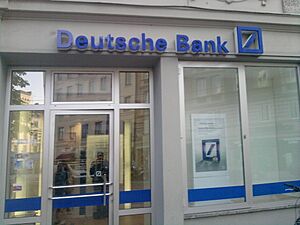
The Corporate & Investment Bank (CIB) is Deutsche Bank's capital markets business. The CIB comprises the below six units.
- Corporate Finance is responsible for advisory and mergers & acquisitions (M&A).
- Equities / Fixed Income & Currencies. These two units are responsible for sales and trading of securities.
- Global Capital Markets (GCM) is focused on financing and risk management solutions. It includes debt and equity issuances.
- Global Transaction Banking (GTB) caters to corporates and financial institutions by providing commercial banking products including cross-border payments, cash management, Securities Services, and international trade finance.
- Deutsche Bank Research provides analysis of products, markets, and trading strategies.
Private and Commercial Bank
- Private & Commercial Clients Germany / International is the retail bank of Deutsche Bank. In Germany, it operates under two brands – Deutsche Bank and Postbank. Additionally, it has operations in Belgium, Italy, Spain and India. The businesses in Poland and Portugal are in the process of being sold.
- Wealth Management functions as the bank's private banking arm, serving high-net-worth individuals and families worldwide. The division has a presence in the world's private banking hotspots, including Switzerland, Luxembourg, the Channel Islands, the Cayman Islands and Dubai.
Deutsche Asset Management (DWS)
Deutsche Bank holds a majority stake in the listed asset manager DWS Group (formerly Deutsche Asset Management), which was separated from the bank in March 2018.
Leadership
After Deutsche Bank was first organized in 1870, the Management Board was represented by a Speaker (German: Vorstandssprecher). Beginning in February 2012, the bank has been led by two co-CEOs; in July 2015 it announced it would be led by one CEO beginning in 2016.
- Hermann Josef Abs, Speaker of the Board 1957-1967
- Karl Klasen, co-Speaker of the Board 1967-1969
- Franz Heinrich Ulrich, co-Speaker of the Board 1967-1976
- Wilfried Guth, co-Speaker of the Board 1976-1985
- Friedrich Wilhelm Christians, co-Speaker of the Board 1976-1988
- Alfred Herrhausen, Speaker of the Board 1985-1989
- Hilmar Kopper, Speaker of the Board 1989-1997
- Rolf-Ernst Breuer, Speaker of the Board 1997-2002
- Josef Ackermann, Speaker of the Board (2002-2006), CEO 2006-2012
- Anshu Jain, co-CEO 2012-2015
- Jürgen Fitschen, co-CEO 2012-2016
- John Cryan, co-CEO 2015-2016, CEO 2016-2018
- Christian Sewing, CEO since 2018
Other notable employees and officers have included:
- Paul Achleitner, long-time chairman of the supervisory board
- Michael Cohrs, former head of Global Banking (2002–2010)
- Sir John Craven – financier in London
- David Folkerts-Landau, head of Research
- Katherine Garrett-Cox, supervisory board member
- Henry Jackson – founder of OpCapita
- Sajid Javid, former managing-director (2007–2009)
- Josh Frydenberg, former director of global banking (2005)
- Otto Hermann Kahn – philanthropist
- Karl Kimmich, former chair (1942–1945)
- Philip May, spouse of a former prime minister of the United Kingdom
- Steven Reich – CEO of Deutsche Bank Trust Company Americas, associate deputy attorney general (2011–2013)
- Georg von Siemens, co-founder and director (1870–1900)
- Georg Solmssen, former chair (short time 1933)
- Johannes Teyssen, (chair of the management board of E.ON)
- Ted Virtue – executive board member
- Hermann Wallich, co-founder and director (1870–1893)
- Boaz Weinstein – derivatives trader
- Chandra Wilson – actress
See also
 In Spanish: Deutsche Bank para niños
In Spanish: Deutsche Bank para niños
- Cash Group
- List of largest banks
- List of corporate collapses and scandals


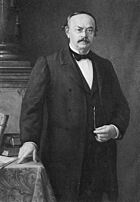

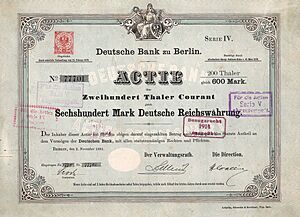
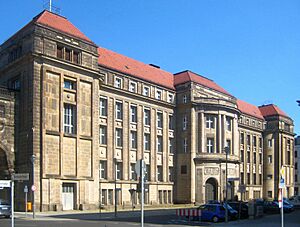

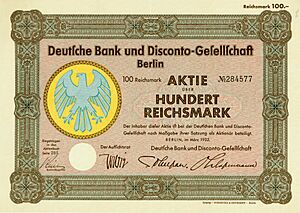
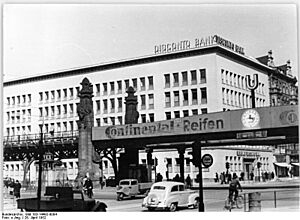
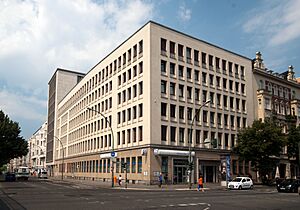




![Branch in Hanover, former Hannoversche Bank [de] (taken over by Deutsche in 1920): 228](/images/thumb/6/68/Hannoversche_Bank_Haus_III_Georgstrasse_Georgsplatz_Mitte_Hannover_Germany_02.jpg/120px-Hannoversche_Bank_Haus_III_Georgstrasse_Georgsplatz_Mitte_Hannover_Germany_02.jpg)
